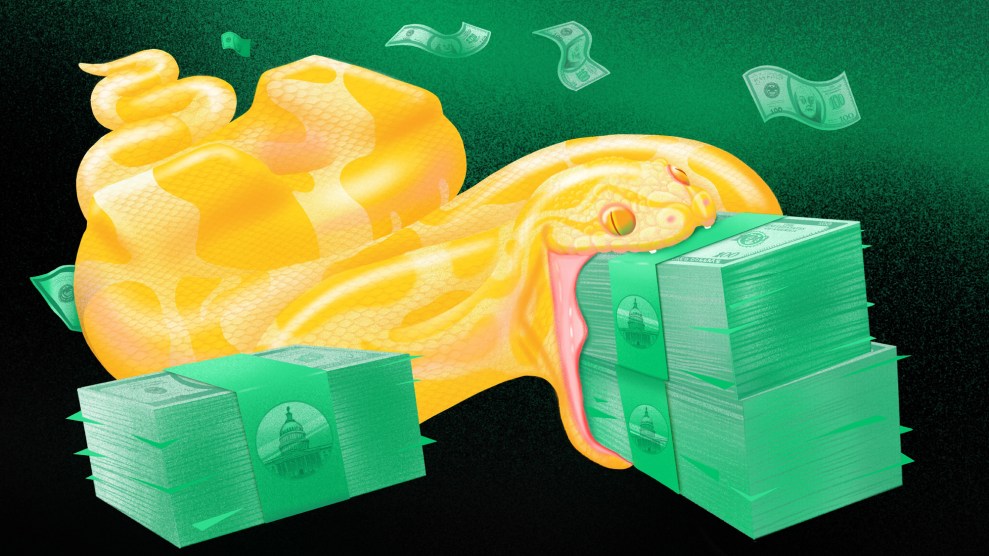
Luminalt solar installers Pam Quan, left, and Walter Morales install solar panels on the roof of a San Francisco home.Justin Sullivan/Getty
This story was originally published by the Guardian and is reproduced here as part of the Climate Desk collaboration.
The Inflation Reduction Act (IRA), passed exactly two years ago, was pitched as a policy that puts the “middle class first.” But the spending bill’s residential tax credits have so far disproportionately benefited wealthy families, new data indicates.
That’s a major challenge for the efforts to decarbonize the US economy in time to avert the worst consequences of the climate crisis. “If going green is just a niche lifestyle choice for the upper middle class, it won’t move the needle on emissions at a societal level,” said Matt Huber, a geography and environment professor at Syracuse University and the author of the 2022 book Climate Change is Class War.
A Treasury Department report published this month shines a light on the use of two IRA renewable energy tax credits: one that helped Americans boost the energy efficiency of their homes by installing heat pumps, electric water heaters, efficient windows and doors, or other upgrades; and another that helped households install small-scale renewable energy production—most commonly rooftop solar panels.
Households living paycheck to paycheck “do not have the savings or credit to buy a new heating/cooling system…even with a complicated incentive to do so.”
In 2023, about 3.4 million households, representing 2.5 percent of all tax filers, took advantage of at least one of these two subsidies, both of which were expansions of pre-existing incentive programs. That represents a 30 percent rise in the use of efficiency and clean energy tax credits over 2021 levels.
Nearly half of those who claimed at least one of these credits last year had incomes lower than $100,000. Yet roughly 75 percent of tax filers had incomes lower than $100,000 in 2023, and a closer look at the use of the credits by households within that bracket shows that wealthier Americans more frequently adopted both tax credits.
Of all filers making less than $100,000, just 0.7 percent claimed the clean energy tax credit, and just 0.9 percent claimed the efficiency incentive. In the over-$100,000 bracket, those percentages rose to 1.6 percent and a stunningly high 4.0 percent.
This dynamic, said Huber, was predictable. Tax credit programs can be difficult to navigate, especially for families who can’t afford to hire tax accountants, he said.
Further, though tax credits can make upgrades more affordable, they may not bring them into reach for Americans with lower incomes, especially because the programs come with spending caps for each household. “Most working-class Americans, living paycheck to paycheck, do not have the savings or credit to buy a new heating/cooling system…even with a complicated incentive to do so,” he said.
The tax incentives also favor those with higher tax burdens. If an upgrade is eligible for up to $2,000 in credits, for instance, filers must owe that amount or more in taxes to receive the full incentive amount.
This marked a substantial change from earlier proposals, which would have made the incentives available even for those with no tax burden. Lew Daly, a senior fellow with the climate justice group Just Solutions, said this was “a tragic political error” that should be changed by Congress.
“Without refundability, most of our country’s millions of moderate- and low-income homeowners are intentionally being excluded from the clean energy transition and its benefits in their everyday life, even as we are giving a massive fortune of tax dollars to big corporations and affluent households through the energy credits program as codified,” he said.
Instead of creating individual incentives, “why not work with utilities on a program that would aim to install heat pumps in every household for free.”
The two credits also require Americans to pay the up-front cost of home upgrades and wait until tax season to recoup costs—an option some households cannot afford.
It’s a major problem for lower-income Americans who are grappling with rising utility bills and a “threadbare social safety net,” said Daly. “The exclusionary design of the energy credits program is just piling on to create a future of worsening inequity.”
Despite these issues, when compared with similar tax incentives that pre-dated the IRA, the distribution of these credits has been more even, said James Sallee, energy economist at the University of California, Berkeley. One study showed 60 percent of benefits went to the top 20 percent of households from 2006 to 2020.
“But, the benefits are still regressive,” Sallee said. “In every income category, the more money you make, the more money on average people are claiming per tax return.”
The IRA does include provisions aimed at promoting equal distribution. The renewable energy tax credit, for instance, can be used to enroll in community solar—a helpful arrangement for renters and apartment dwellers who tend to have lower incomes than house-owners.
The bill also includes point-of-sale rebates for efficient appliances and upgrades, though their rollout has been slow because they are being distributed locally. Only two states have yet to offer rebates, though others could launch their programs within months.
Other changes could help change the distribution of tax credits, said Sallee. One of them: placing income caps on eligibility.
But ultimately, said Huber, to create green benefits that are easier for all Americans to access, they should be universal rather than means-tested.
“Instead of putting out incentives for individual households, why not work with utilities on a program that would aim to install heat pumps in every household for free,” he asked. “That might sound outlandish, but if we see solving climate change [as] critical to the public good, there’s no reason why decarbonization shouldn’t be seen as a core public service like healthcare or education.”















